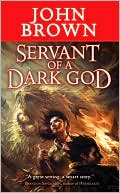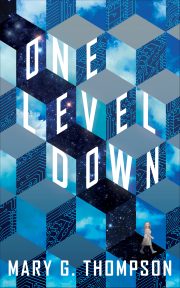Key Conditions for Suspense:
Part 10 – Clarity, the first principle of plot
by John D. Brown
 The following is part of a continuing series. If you wish to start at the beginning, head to It’s All About The Reader.
The following is part of a continuing series. If you wish to start at the beginning, head to It’s All About The Reader.
In parts 1-4, I talked about the story problem and its central role in reader suspense. I also talked about a man scratching his bum.
In parts 5-9, I discussed the three character factors that are critical for reader suspense and how they also help make a character rock.
So let’s say you’ve already got all that. You’ve developed a character who is sympathetic and interesting, maybe tugs on the reader’s sense of wish-fulfillment. You’ve given that character a problem that’s significant enough for readers to be intrigued. Now what?
Let’s go back to the objective. Readers want to hope and fear for a character; they want their tension to build to a pitch. Then they want to have a cathartic release.
Character and problem by themselves don’t go anywhere. You still have to build reader tension to a sharp point. So how do you do that?
You do it with plot.
Plot is nothing more than the character’s attempts to solve the problem and the results of those attempts. There’s no mystery to it. A character has a problem. Character tries to solve the problem. And something happens as a result.
The key is to remember that the plot has a job to do. You can’t have your characters go about solving the problem in any old way. You can’t have just any old results. Form follows function. To deliver what readers want, you have to develop the plot in a manner that builds the reader’s tension. If the story’s about a happiness problem, all of the attempts and results should increase the reader’s hope or fear for the character. If it’s a mystery problem, the attempts and results should increase the reader’s curiosity.
In the next set of posts, I’m going to discuss the Pareto factors for doing this. And these factors all revolve around making the problem hard to solve.
Clarity
The first part of making problems hard to solve has to do with clarity.
(Blink)
Wait a minute. Clarity? Um, what? How exactly does that make a problem hard to solve?
Clarity doesn’t make problems harder to solve. What is does is provide the critical function of allowing the problem to exist in the reader’s mind in the first place. The simple truth is that readers cannot hope and fear for anything if they don’t understand what’s going on.
So the very first thing you do is make sure the reader knows or suspects what’s at stake, i.e. what’s to be gained or lost. They need to understand something of the danger/threat, lack/opportunity, or mystery. They also need to know or suspect why it’s going to be difficult to solve the problem or take advantage of the opportunity. This means the reader will need to know about or suspect possible obstacles and conflicts the character may have to face.
This doesn’t mean you have to reveal all. It just means there must be something to fear and hope for.
When you don’t explain the danger or opportunity or mystery, then the most the reader can feel is confusion, maybe brief moments of surprise. Imagine a thriller that fails to establish that Bob kidnapped George’s wife who is a Chinese spy. George and Bob run around for 100 pages and the whole time the reader is thinking: “When’s the story going to start? What’s going on? Why is George chasing Bob?”
The classic example of this is given by Alfred Hitchcock in an interview conducted by Francois Truffaut. Here’s Hitchcock.
“There is a distinct difference between ‘suspense’ and ‘surprise’, and yet many pictures continually confuse the two. I’ll explain what I mean.
“We are now having a very innocent little chat. Let us suppose that there is a bomb underneath this table between us. Nothing happens, and then all of a sudden, ‘Boom!’ There is an explosion. The public is surprised, but prior to this surprise, it has seen an absolutely ordinary scene, of no special consequence. Now, let us take a suspense situation. The bomb is underneath the table, and the public knows it, probably because they have seen the anarchist place it there. The public is aware that the bomb is going to explode at one o’clock and there is a clock in the décor. The public can see that it is a quarter to one. In these conditions this same innocuous conversation becomes fascinating because the public is participating in the scene.
“The audience is longing to warn the characters on the screen: ‘You shouldn’t be talking about such trivial matters. There’s a bomb underneath you and it’s about to explode!’
“In the first case we have given the public fifteen seconds of surprise at the moment of the explosion. In the second case we have provided them with fifteen minutes of suspense. The conclusion is that whenever possible the public must be informed. Except when the surprise is a twist, that is, when the unexpected ending is, in itself, the highlight of the story.” (François Truffaut, Hitchcock, pp 79-80)
Hitchcock gives two more great examples in his essay “The Enjoyment of Fear,” first published in Good Housekeeping in 1949. (I think there’s some zing in the juxtaposition of housekeeping and the enjoyment of fear, don’t you think? Magazines were so different back then.)
Readers feel surprise when something unexpected occurs. By definition, they do not see it coming, even if it makes sense after the fact. So to create this effect you need to withhold information and lead the reader to have different expectations. Then wham!
Readers feel curiosity when they’re given enough information to form a question but not the answer. For example, in a murder mystery, we know someone’s been killed, but who did it? And why? In another story, like Jack McDevitt’s Ancient Shores, the character finds an odd thing in the ground at his farm. When he digs it up, he finds a modern-looking boat made of a material more refined than any known to man. We know what he found, but what is this and how did it get into his field? With other stories where characters face dangers and lacks, readers feel curiosity about what might happen next.
However, if we want our readers to hope and fear for a character, we have to give readers more information. We have to let them know what’s at risk—what’s to be lost or gained. We have to let them know what the obstacles and conflicts are, what MIGHT happen. After all, how can you fear for a character if it’s smooth sailing to the finish line?
No information = no possibilities in the reader’s mind = no expectations = no suspense.
This isn’t to say we must eschew surprise and curiosity. Both are delicious. In fact, both actually help create suspense. So the point isn’t to avoid them. The point is to make sure we understand that we cannot create suspense by withholding the situation. We create it by giving the reader all the information we can without giving away all the details of the resolution or key plot turns until the moment they occur.
BTW, I say “all the details” because sometimes, despite our best attempts, the reader will see some of the plot turns coming. But if we’ve done it right (fingers crossed), on those occasions they will only see a part, and the part they don’t see will pack enough surprise or particularity to delight.
Now that we know we need to be clear, we can look at exactly what we’re to be clear about. And that will be the topic of the next few posts in the series.
Happiness,
John
•••
 John Brown is an award-winning novelist and short story writer. Servant of a Dark God, the first book in his epic fantasy series, was published by Tor Books and is now out in paperback. Forthcoming novels in the series include Curse of a Dark God and Dark God’s Glory. He currently lives with his wife and four daughters in the hinterlands of Utah where one encounters much fresh air, many good-hearted ranchers, and an occasional wolf.
John Brown is an award-winning novelist and short story writer. Servant of a Dark God, the first book in his epic fantasy series, was published by Tor Books and is now out in paperback. Forthcoming novels in the series include Curse of a Dark God and Dark God’s Glory. He currently lives with his wife and four daughters in the hinterlands of Utah where one encounters much fresh air, many good-hearted ranchers, and an occasional wolf.
For a list of all of the posts in this series thus far, click on the “John D. Brown” tag.


